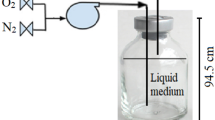Abstract
From various oxic or anoxic habitats anaerobic enrichment cultures were set up which completely oxidized aromatic amino acids to CO2 with nitrate as electron acceptor. Tyrosine and tryptophan at first were degraded to phenol and indole, respectively, prior to utilization of the aromatic ring; with phenylalanine no intermediates were detected. Attempts to isolate denitrifying bacteria able to completely degrade aromatic amino acids were unsuccessful. Starting with these enrichments several strains of denitrifying bacteria were anaerobically enriched and isolated with known fermentation products of amino acids (phenylacetate, 4-OH-phenylacetate, 2-OH-benzoate) plus nitrate as sole sources of carbon and energy.
Three strains were characterized further. They grew well in defined mineral salts medium, were gram-negative and facultatively anaerobic with strictly oxidative metabolism; molecular oxygen, nitrate or nitrite served as electron acceptors. The isolates were tentatively identified as pseudomonads, but could not be aligned to known species. They oxidized a variety of aromatic compounds completely to CO2 anaerobically and, with some exceptions, also aerobically. The substrates included among others: (4-OH)-phenylacetate, (4-OH)-phenylglyoxylate, benzoate, 2-aminobenzoate, phenol, OH-benzoates, indole and notably toluene. Reduced alicyclic compounds were not utilized. During anaerobic degradation of (4-OH)-phenylacetate transient accumulation of (4-OH)-phenylglyoxylate was observed.
It is proposed that anaerobic α-oxidation of the-CH2−COOH side chain to -CO−COOH initiates anaerobic degradation of (4-OH)-phenylacetate. This implies a novel type of anaerobic α-hydroxylation with water as the oxygen donor.
Similar content being viewed by others
References
Bak F, Widdel F (1986) Anaerobic degradation of phenol and phenol derivatives by Desulfobacterium phenolicum sp. nov. Arch Microbiol 146:177–180
Balba MT, Evans WC (1979) The methanogenic fermentation of w-phenyl alkane carboxylic acids. Biochem Soc Trans 7:403–405
Balba MT, Evans WC (1980) Methanogenic fermentation of the naturally occuring aromatic amino acids by a microbial consortium. Biochem Soc Trans 8:625–627
Bossert YD, Young LY (1986) Anaerobic oxidation of p-cresol by a denitrifying bacterium. Appl Environ Microbiol 52:1117–1122
Bradford MM (1976) A rapid and sensitive method for the quantitation of microgram quantities of protein utilizing the principle of protein-dye binding. Anal Biochem 72:248–254
Dangel W, Brackmann R, Lack A, Magdy M, Koch J, Oswald B, Seyfried B, Tschech A, Fuchs G (1991) Differential expression of enzyme activities initiating anoxic metabolism of various aromatic compounds via benzoyl-CoA. Arch Microbiol 155:256–262
D'Ari L, Barker HA (1985) p-Cresol formation by cell-free extracts of Clostridium difficile. Arch Microbiol 143:311–312
DeLey J (1970) Reexamination of the association between melting point, buoyant density and the chemical base composition of deoxyribonucleic acid. J Bacteriol 101:738–754
Elsden SR, Hilton MG, Waller JM (1976) The end products of the metabolism of aromatic amino acids by clostridia. Arch Microbiol 107:283–288
Evans WC, Fuchs G (1988) Anaerobic degradation of aromatic compounds. Annu Rev Micribiol 42:289–317
Gesellschaft Deutscher Chemiker (1979) Deutsche Einheitsverfahren zur Wasser-, Abwasser- und Schlammuntersuchung. 8. Lieferung, D9, pp 1–8
Gregersen T (1978) Rapid method for distinction of gram-negative from gram-positive bacteria. Eur J Appl Microbiol Biotechnol 5:123–127
Imhoff-Stuckle D, Pfennig N (1983) Isolation and characterization of a nicotinic acid-degrading sulfate-reducing bacterium, Desulfococcus niacini sp. nov. Arch Microbiol 136:194–198
Magee CM, Rodeheaver G, Edgerton MT, Edlich RF (1975) A more reliable gram-staining technic for diagnosis of surgical infections. Am J Surg 130:341–346
Marmur J (1961) A procedure for the isolation of deoxyribonucleic acid from microorganisms. J Mol Biol 3:208–218
Martin AK (1982) The originof urinary aromatic compounds excreted by ruminants. 3. The metabolism of phenolic compounds to simple phenols. Br J Nutr 48:497–507
Pfennig N (1978) Rhodocyclus purpureus gen. nov. and sp. nov., a ring-shaped, vitamin B12-requiring member of the family Rhodospirillaceae. Int J Syst Bacteriol 28:283–288
Rider BF, Mellon MG (1946) Colorimetric determination of nitrites. Ind Eng Chem 18:96–98
Rudolphi A, Tschech A, Fuchs G (1991) Anaerobic degradation of cresols by denitrifying bacteria. Arch Microbiol 155:238–248
Schink B (1988) Principles and limits of anaerobic degradation: environmental and technological aspects. In: Zehnder AJB (ed) Biology of anaerobic microorganisms. Wiley & Sons, New York, pp 771–846
Scott TW, Ward PFV, Dawson RMC (1964) The formation and metabolism of phenyl-substituted fatty acids in the ruminant. Biochem J 90:12–24
Sembiring T, Winter J (1989) Anaerobic degradation of phenylacetic acid by mixed and pure cultures. Appl Microbiol Biotechnol 31:84–88
Spoelstra SF (1977) Simple phenols and indoles in anaerobically stored piggery wastes. J Sci Fed Agric 28: 415–423
Tschech A, Fuchs G (1987) Anaerobic degradation of phenol by pure cultures of newly isolated denitrifying pseudomonads. Arch Microbiol 148:213–217
Tschech A, Fuchs G (1989) Anaerobic degradation of phenol via carboxylation to 4-OH-benzoate: in vitro study of isotope exchange between 14CO2 and 4-hydroxybenzoate. Arch Microbiol 152:594–599
Tschech A, Pfennig N (1984) Growth yield increase linked to the caffeate reduction in Acetobacterium woodii. Arch Micribiol 137:163–167
Ward LA, Johnson KA, Robinson JM, Yokoyama MT (1987) Isolation from swine feces of a bacterium which decarboxylates p-hydroxyphenylacetic acid to 4-methylphenol (p-cresol). Appl Environ Microbiol 53:189–192
Widdel F, Pfennig N (1984) Dissimilatory sulfate-or sulfur-reducing bacteria. In: Krieg NR, Holt JG (eds) Bergey's manual of systematic bacteriology, vol 1, 9th edn. Williams & Wilkins, Baltimore London, pp 663–679
Widdel F, Kohring GW, Mayer F (1983) Studies on dissimilatory sulfate-reducing bacteria that decompose fatty acids. III. Characterization of the filamentous gliding Desulfonema limicola gen. nov. sp. nov., and Desulfonema magnum sp. nov. Arch Microbiol 134:286–294
Yokoyama MT, Carlson JR (1981) Production of skatole and paracresol by a rumen Lactobacillus sp. Appl Environ Microbiol 41:71–76
Author information
Authors and Affiliations
Additional information
Abbreviation. Hydroxyl groups were abbreviated as OH
Rights and permissions
About this article
Cite this article
Seyfried, B., Tschech, A. & Fuchs, G. Anaerobic degradation of phenylacetate and 4-hydroxyphenylacetate by denitrifying bacteria. Arch. Microbiol. 155, 249–255 (1991). https://doi.org/10.1007/BF00252208
Received:
Accepted:
Issue Date:
DOI: https://doi.org/10.1007/BF00252208




